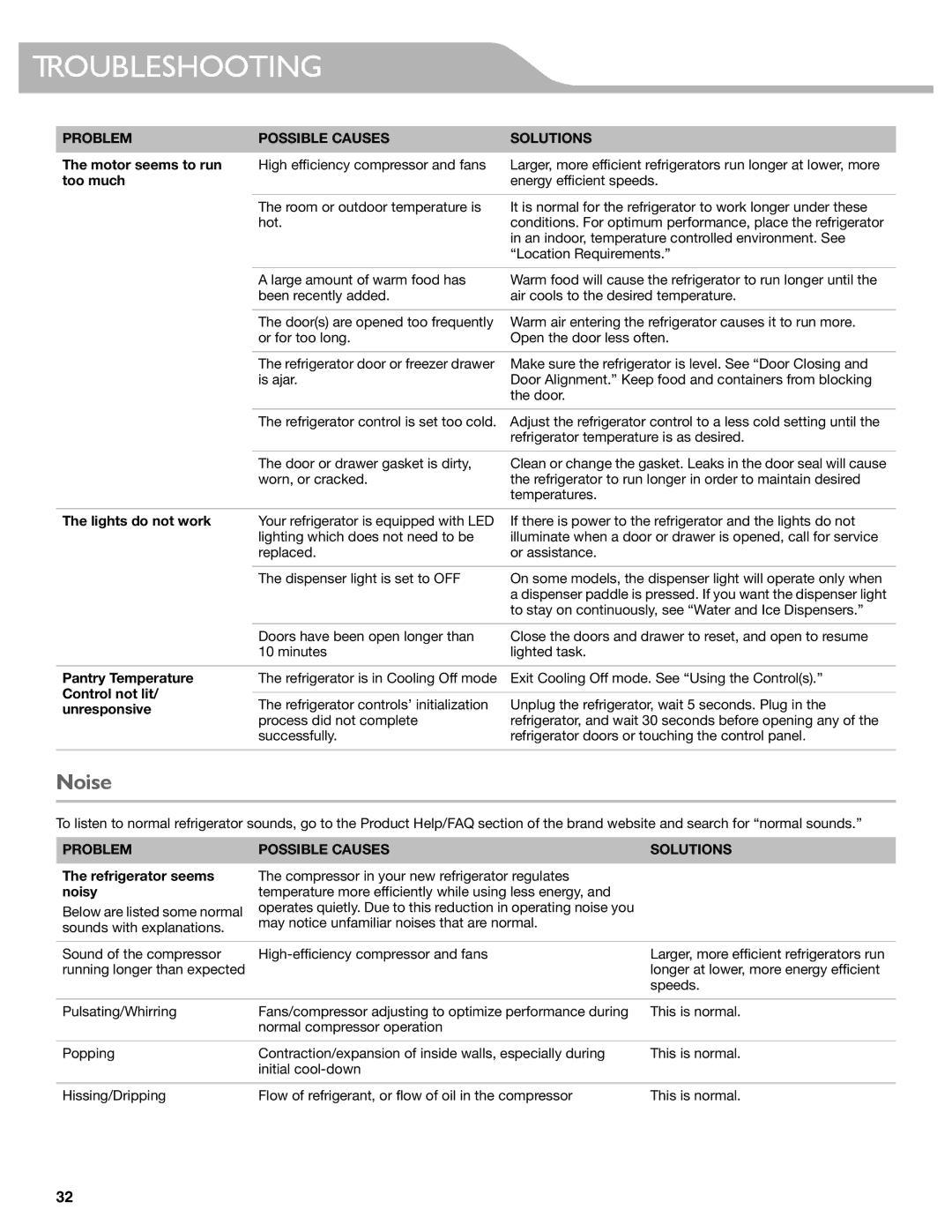
TROUBLESHOOTING
PROBLEM | POSSIBLE CAUSES | SOLUTIONS | |
|
|
| |
The motor seems to run | High efficiency compressor and fans | Larger, more efficient refrigerators run longer at lower, more | |
too much |
| energy efficient speeds. | |
|
|
| |
| The room or outdoor temperature is | It is normal for the refrigerator to work longer under these | |
| hot. | conditions. For optimum performance, place the refrigerator | |
|
| in an indoor, temperature controlled environment. See | |
|
| “Location Requirements.” | |
|
|
| |
| A large amount of warm food has | Warm food will cause the refrigerator to run longer until the | |
| been recently added. | air cools to the desired temperature. | |
|
|
| |
| The door(s) are opened too frequently | Warm air entering the refrigerator causes it to run more. | |
| or for too long. | Open the door less often. | |
|
|
| |
| The refrigerator door or freezer drawer | Make sure the refrigerator is level. See “Door Closing and | |
| is ajar. | Door Alignment.” Keep food and containers from blocking | |
|
| the door. | |
|
| ||
| The refrigerator control is set too cold. Adjust the refrigerator control to a less cold setting until the | ||
|
| refrigerator temperature is as desired. | |
|
|
| |
| The door or drawer gasket is dirty, | Clean or change the gasket. Leaks in the door seal will cause | |
| worn, or cracked. | the refrigerator to run longer in order to maintain desired | |
|
| temperatures. | |
|
|
| |
The lights do not work | Your refrigerator is equipped with LED | If there is power to the refrigerator and the lights do not | |
| lighting which does not need to be | illuminate when a door or drawer is opened, call for service | |
| replaced. | or assistance. | |
|
|
| |
| The dispenser light is set to OFF | On some models, the dispenser light will operate only when | |
|
| a dispenser paddle is pressed. If you want the dispenser light | |
|
| to stay on continuously, see “Water and Ice Dispensers.” | |
|
|
| |
| Doors have been open longer than | Close the doors and drawer to reset, and open to resume | |
| 10 minutes | lighted task. | |
|
|
| |
Pantry Temperature | The refrigerator is in Cooling Off mode | Exit Cooling Off mode. See “Using the Control(s).” | |
Control not lit/ |
|
| |
The refrigerator controls’ initialization | Unplug the refrigerator, wait 5 seconds. Plug in the | ||
unresponsive | |||
process did not complete | refrigerator, and wait 30 seconds before opening any of the | ||
| |||
| successfully. | refrigerator doors or touching the control panel. | |
|
|
| |
Noise
To listen to normal refrigerator sounds, go to the Product Help/FAQ section of the brand website and search for “normal sounds.”
PROBLEM | POSSIBLE CAUSES | SOLUTIONS |
|
|
|
The refrigerator seems | The compressor in your new refrigerator regulates |
|
noisy | temperature more efficiently while using less energy, and |
|
Below are listed some normal | operates quietly. Due to this reduction in operating noise you |
|
may notice unfamiliar noises that are normal. |
| |
sounds with explanations. |
| |
|
| |
|
|
|
Sound of the compressor | Larger, more efficient refrigerators run | |
running longer than expected |
| longer at lower, more energy efficient |
|
| speeds. |
|
|
|
Pulsating/Whirring | Fans/compressor adjusting to optimize performance during | This is normal. |
| normal compressor operation |
|
|
|
|
Popping | Contraction/expansion of inside walls, especially during | This is normal. |
| initial |
|
|
|
|
Hissing/Dripping | Flow of refrigerant, or flow of oil in the compressor | This is normal. |
32
